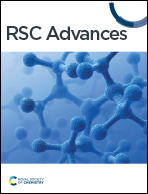KMnCuTe2: a layered antiferromagnetic semiconductor with long metal–metal distance†
Abstract
The magnetic semiconductor in a two-dimensional system is a major subject for both theoretical and experimental investigations. Here we report the synthesis of a new quaternary manganese chalcogenide KMnCuTe2, which shows layered structure and antiferromagnetic (AFM) semiconducting features. Single crystals of KMnCuTe2 were obtained using a self-flux method and based on single-crystal X-ray diffraction, KMnCuTe2 adopts the ThCr2Si2-type structure composed of edge-sharing tetrahedral layers separated by K+ cations. The Mn and Cu atoms randomly distribute in the centre of tetrahedral units. Attributed to the large radius of Te, KMnCuTe2 has large lattice parameters (a = 4.3115(3) Å and c = 14.9360(20) Å), leading to a long metal–metal distance (3.049 Å) in the tetrahedral layers. Based on the experiments and theoretical calculations, KMnCuTe2 exhibits a G-type AFM interaction with the transition temperature at around 225 K and an indirect semiconducting nature with the band gap of 0.95 eV. The magnetic semiconducting property of KMnCuTe2 is unique in AMnMCh2 systems (A = Li, Na, K, M = Cu, Ag and Ch = S, Se, Te), which could be associated with the large metal–metal distance. Our work not only highlights the role of metal–metal interactions on regulating the properties of ThCr2Si2-type compounds, but also provides a feasible strategy to obtain the layered magnetic semiconductor.



 Please wait while we load your content...
Please wait while we load your content...